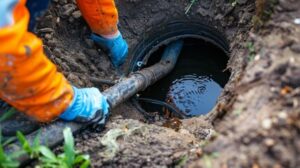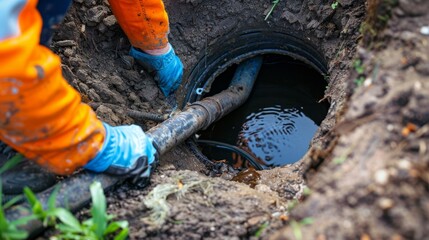Liquid waste is any type of non-solid waste that exists in liquid form. It can be hazardous or non-hazardous, but both require specialized treatment and disposal processes. Reach out to Liquid Waste Disposal Perth for expert assistance.

Environmental Hazards: When liquid waste is disposed of improperly, it can contaminate water sources that people drink from, harming ecosystems and causing long-term health risks. It can also clog sewer systems or corrode pipes, leading to expensive repairs.
The cost of managing and disposing of liquid waste is an important factor to consider. If left untreated, improperly disposed of, or not managed effectively, liquid waste can leach into groundwater and cause environmental pollution. Additionally, it can contaminate waterways and harm plant, animal and human life. Therefore, it’s vital to make sustainable disposal a priority for any business that generates liquid waste.
Businesses that produce liquid waste should set up measures to contain it and either treat it onsite using their own facilities or send it out to a waste management company for treatment and disposal. This can help to minimise the risks associated with the disposal process, such as contamination of soil and groundwater, air emissions, pathogen exposure, and chemical exposure.
It’s also important to keep in mind that treating and disposing of liquid waste is often more expensive than treating and disposing of solid waste. This is because treating and transporting liquid waste requires more resources than solid waste. It’s also crucial to consider the location of the disposal site when determining the overall costs, as this can have a significant impact on how much you’ll pay.
Depending on where you live, your local landfill may be more or less accessible than others. This can affect the overall cost of going to the dump, as you’ll need to factor in fuel costs and the value of your time.
If you’re taking your hazardous waste to a local disposal site, it’s a good idea to research what their rules and regulations are before you go. You’ll want to ensure that you follow all of the necessary procedures to avoid any fines or penalties.
Another thing to keep in mind is the potential for a state surcharge on liquid waste disposal. This could have a big effect on the costs of disposal, as it would add an extra expense for businesses and individuals. It’s important to find a balance, though, as the fee needs to be high enough to discourage illegal dumping and encourage people to reduce their waste.
Regulations
Regardless of the type of liquid waste that you produce, it is important to dispose of it responsibly. This will protect your workers and the environment from hazardous substances and ensure that you comply with regulations. Moreover, proper disposal can also help you save money by avoiding costly fines and penalties.
The first step in disposing of liquid waste is separating it into non-hazardous and hazardous materials. Then, you can choose a treatment method that meets local regulations and guidelines.
Different types of liquid waste require different treatment methods. Some may be able to be composted while others might require chemical or incineration treatments. Ultimately, you will need to find an appropriate landfill or disposal site.
If you are unsure about what type of liquid waste your facility generates, you can consult a specialist for guidance. They can provide you with a list of available options, including the best disposal site for your needs.
When liquid waste is improperly handled, it can contaminate soil, water, and even air. This can lead to many health risks, such as skin irritations or respiratory problems. It can also cause long-term damage to the environment and infrastructure. Moreover, it can affect the quality of our food supply by entering our drinking water supplies.
Some of the most common sources of liquid waste include manufacturing and agricultural industries. These industries produce a variety of liquid wastes, including wastewater and chemical spills. Other common types of liquid waste include sewage, animal waste, and solvents.
Occupational Safety and Health Administration (OSHA) regulations require companies to follow specific procedures for handling, storage, and disposal of liquid waste. These rules help minimize worker injuries and illnesses. In addition, these regulations prevent environmental contamination and reduce the impact of waste on human health.
Proper liquid waste management requires a detailed record-keeping system. It is essential for proving compliance with regulatory standards during inspections and investigations. Besides, it helps you identify areas where your operations need improvement.
Moreover, accurate records can help you avoid hefty fines and legal actions. Improper disposal of liquid waste can contaminate water sources, causing severe ecological damage. It can also clog sewer systems and cause overflows. It can also corrode pipes and equipment, leading to expensive repair and replacement costs.
Types of Waste
Liquid waste can occur from a number of sources. It may be a result of household activities, industrial processes, or agricultural production. Regardless of the source, it must be safely disposed of to prevent environmental harm. It can be hazardous, toxic or corrosive and requires specialized handling and disposal methods. Using these methods ensures that the liquid waste doesn’t leak into vital waterways or cause contamination of human and animal health.
There are a variety of ways to manage liquid waste, including collection, storage, and treatment. Some of these processes use chemicals to neutralize the harmful properties of the liquids. Others involve heating the waste to turn it into a solid material. For example, liquid waste from septic systems is usually stored in tanks until it can be pumped into transportation tanks for further processing. This helps to prevent septic system tank problems and other issues that can be expensive to deal with.
Other forms of liquid waste include medical, industrial and agricultural waste. Medical waste includes sewage, blood and other bodily fluids that are potentially hazardous to humans. This waste is collected and disposed of by professional waste management services. Industrial waste is a byproduct of many industrial processes, such as paper and textiles manufacturing, chemical processing and oil and gas refining. This waste is typically concentrated and has a high chemical content. Finally, agricultural waste includes the runoff and byproducts from livestock and farming activities.
In order to dispose of liquid waste, it must first be separated into non-hazardous and hazardous substances. This process is done by separating the different liquids based on their potential to affect the environment and human health. Once the waste is categorized, it can be treated and disposed of in a manner that ensures compliance with regulations.
There are several options for the disposal of liquid waste, including incineration. This method heats the waste to a high temperature, vaporizing most of its harmful compounds. However, it is still possible for some of these compounds to leak out into the atmosphere. The best option for preventing this is to use an environmentally friendly disposal method, such as chemical treatment or filtration.
Treatment
The different types of liquid waste pose unique challenges for proper disposal. Some are corrosive, toxic, or flammable, which requires special handling and disposal procedures to mitigate risk to human health and the environment. Most importantly, proper disposal minimizes the impact of the waste on water resources, such as rivers, lakes, and groundwater. It also prevents soil contamination, which could reduce the ability of land to sustain plants and animal life.
Liquid wastes must be contained in safe and secure areas before being transported to treatment facilities. Depending on the type of waste, this can be done in a variety of ways. For example, sewage or blackwater can be stored in septic tanks or holding ponds. Greywater can be treated and reused for irrigation or toilet flushing. Other waste materials can be processed through anaerobic digestion or composting to produce biogas and fertilizers, embodying the principles of a circular economy.
Once at the treatment facility, the first step is to screen and separate the liquid waste to remove larger particles or non-organic contaminants. This can be accomplished using techniques like gravity settlers and mechanical separators. The next step is to disinfect the liquid waste, which can be done through various methods, including chlorination and UV disinfection. Disinfecting liquid waste prevents the spread of diseases and limits the growth of pathogens.
Another option is to apply the waste to the earth, which can be used as a crop irrigation method or as a nutrient source for soil. However, this method is often more expensive and requires careful consideration of environmental impacts. For example, if the waste is to be applied to surface water sources, such as lakes or rivers, it must be kept far away from drinking water sources. Similarly, ocean dumping is now rarely used because it can cause severe harm to marine ecosystems.
Liquid waste management is a vital aspect of business operations, but it can be a challenging task. This waste type is heavily regulated, and even small infractions can result in hefty fines. However, a comprehensive waste management plan that considers all disposal options can help companies manage this difficult type of waste.



